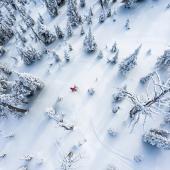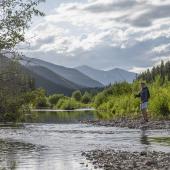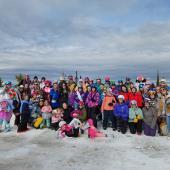Up Early
For sweet spring corn.
Spring is one of my favorite times to ski. The days are warmer and longer, and if you hit it right, backcountry "corn" can seem like 2,000-foot groomers, without the cost or the crowds. However, to taste the fruits your timing needs to be impeccable.
Spring cycles of warm days and cold nights turn the snow surface into big grains called "corn snow." For a few hours, between the rock-hard, bulletproof, early-morning crust and the slushy afternoon hours, you'll be in carving heaven.
The spring sun is higher in the sky, which increases the angle and amount of solar radiation hitting the snowpack. In essence, the snow begins to melt and water percolates down into the snowpack. If the temperatures freeze hard, the snowpack seizes up like concrete with the frozen water channels acting like rebar, creating very solid bonds reinforcing the snowpack. These are times when the avalanche danger is low and nothing short of a nuclear bomb will get it to move.
As the sun rises, the temperatures warm and the frozen surface starts to melt. This is the window you're shooting for: the initial melt. If you go out too early, you'll chatter the fillings out of your mouth trying to make a turn. And if you sleep in and wait too long, you'll find yourself sinking to the ground as the snow loses all its strength. The bad thing about waiting too long—besides the hateful skiing conditions—is that the avalanche dangers will rapidly rise too.
Dry snow avalanches occur because weak layers are loaded to the point of failure. It snows and snows until the layer fails. Wet avalanches, on the other hand, fail because the layers themselves lose strength as their bonds melt. If it gets warm enough, the bonds melt through the entire snowpack and you crash to the ground on your skis—not a pleasant experience.
How can you tell if the avalanche danger is rising? If you notice that pinwheels are spinning downhill, getting bigger as they roll until they resemble Goliath-sized cinnamon rolls, it's getting too late to ski. The same if you step out of your skis and sink past your boots in wet glop. Both of these are signs that the snow is losing strength and the avalanche danger is worsening. Ideally, the snow will freeze again overnight, giving you another chance of making turns the next day. However, if there are three or more days of round-the-clock above-freezing temperatures, look out, because large avalanche cycles can follow.
Nature will reward those disciplined enough to get up early. Imagine skiing a long, open run with your edges biting, carving the perfect turn. It's there if you want it.
Doug Chabot is the director of the Gallatin National Forest Avalanche Center.











